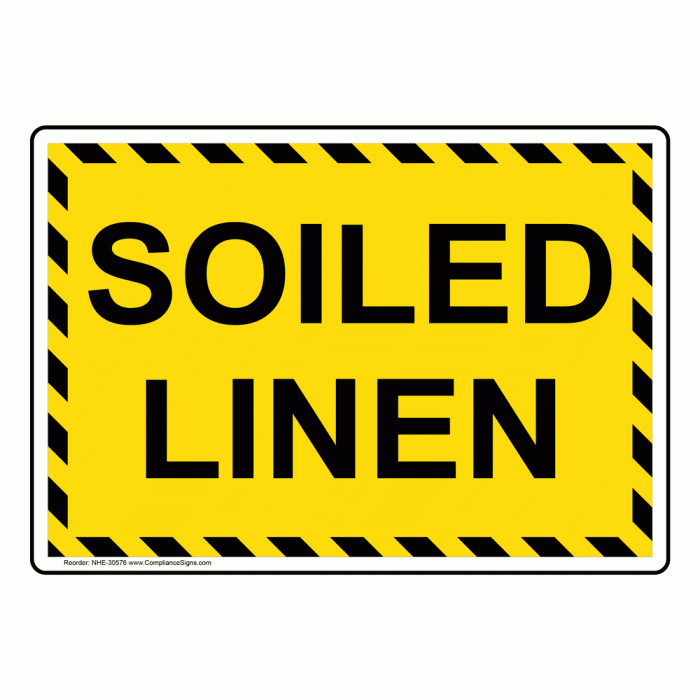Soiled linen should be bagged immediately to prevent the spread of infection. Improper handling of soiled linen can lead to cross-contamination and the transmission of harmful microorganisms. This article will delve into the importance of proper soiled linen handling, infection control measures, environmental considerations, regulatory compliance, and staff training.
Soiled Linen Handling Procedures
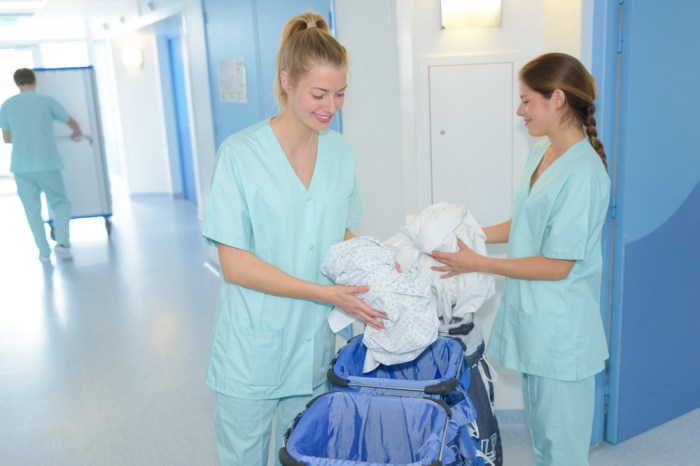
Proper handling of soiled linen is crucial in healthcare facilities to prevent the spread of infections and maintain hygiene. This involves following specific procedures for bagging and disposing of soiled linen to minimize the risk of contamination.
Bagging Soiled Linen
- Wear appropriate personal protective equipment (PPE) such as gloves and gowns when handling soiled linen.
- Separate heavily soiled linen, such as those with bodily fluids or excretions, from lightly soiled linen.
- Place soiled linen directly into designated bags without shaking or waving.
- Fill bags to no more than two-thirds of their capacity to allow for proper ventilation.
- Close bags securely and tie them tightly to prevent spillage.
- Label bags clearly with the type of linen, date, and any special handling instructions.
Types of Bags for Soiled Linen
There are various types of bags suitable for soiled linen, including:
- Disposable bags:Single-use bags made of plastic or paper that can be discarded after use.
- Reusable bags:Durable bags made of fabric or synthetic materials that can be laundered and reused multiple times.
- Leak-proof bags:Bags with an impermeable lining to prevent leakage of bodily fluids.
- Biodegradable bags:Bags made from plant-based materials that decompose over time.
Infection Control Measures: Soiled Linen Should Be Bagged
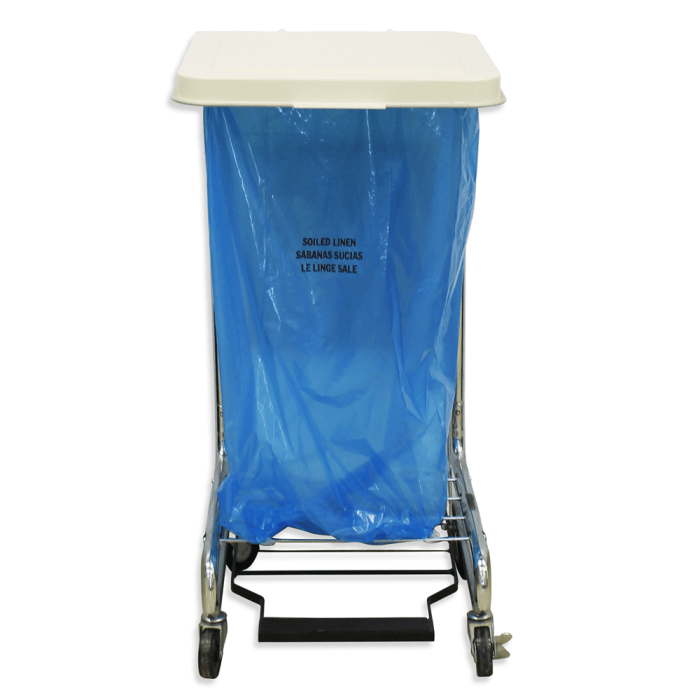
Soiled linen, including used linens, bedding, towels, and other textiles, plays a critical role in infection control within healthcare settings. Improper handling of soiled linen can lead to the spread of infection among patients, healthcare workers, and visitors.
Soiled linen can be contaminated with microorganisms, such as bacteria, viruses, and fungi, which can cause infections if they come into contact with susceptible individuals. Improper handling, such as leaving soiled linen on the floor, sorting it in open areas, or transporting it without proper containment, can result in the release of these microorganisms into the environment, increasing the risk of infection transmission.
Strategies for Preventing Cross-Contamination
To prevent cross-contamination and ensure infection control, healthcare facilities implement various strategies:
- Proper Bagging and Transport:Soiled linen should be bagged in leak-proof, color-coded bags to prevent the spread of microorganisms during transport and storage.
- Designated Soiled Linen Areas:Dedicated areas should be designated for handling and storing soiled linen, separate from clean linen and patient care areas.
- Regular Linen Changes:Linens should be changed regularly to prevent the accumulation of microorganisms and reduce the risk of infection.
- Hand Hygiene:Healthcare workers should practice proper hand hygiene before and after handling soiled linen to prevent the transmission of microorganisms.
- Education and Training:Staff should be educated and trained on proper soiled linen handling procedures to ensure compliance and prevent infection transmission.
Environmental Considerations
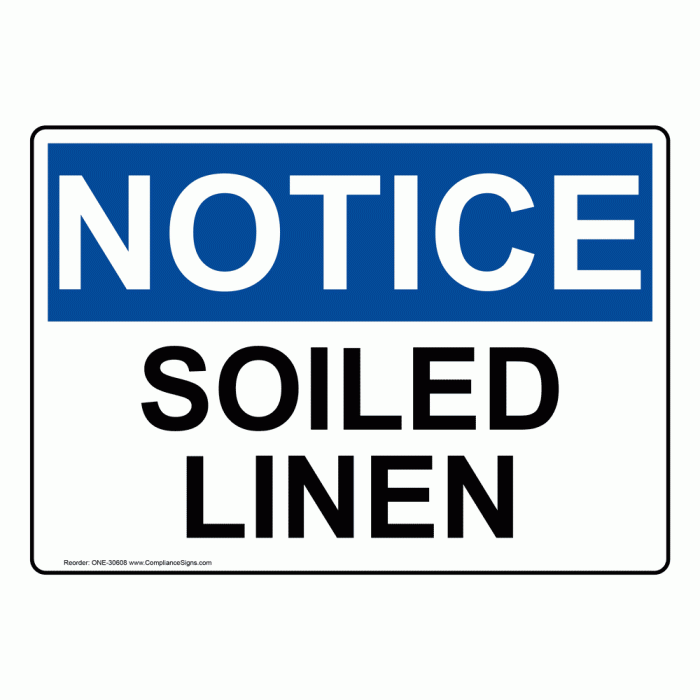
Soiled linen has a significant environmental impact. Improper disposal and handling can lead to pollution, while proper disposal and recycling can reduce waste and conserve resources.
When soiled linen is not properly disposed of, it can contaminate soil and water sources. The chemicals and detergents used in laundering can also harm the environment. In addition, soiled linen that is not recycled ends up in landfills, where it takes up valuable space and releases harmful gases into the atmosphere.
Soiled linen, especially those heavily soiled, should be bagged separately to prevent contamination. You can find more tips about i am alfonso jones characters here. As mentioned, soiled linen should be bagged to avoid cross-contamination, especially when handling heavily soiled items.
Sustainable Practices in Soiled Linen Management
There are a number of sustainable practices that can be implemented in soiled linen management. These practices include:
- Using eco-friendly detergents and cleaning agents
- Recycling soiled linen
- Composting soiled linen
- Reducing the use of water and energy in laundering
By implementing these practices, healthcare facilities can reduce their environmental impact and contribute to a more sustainable future.
Regulatory Compliance
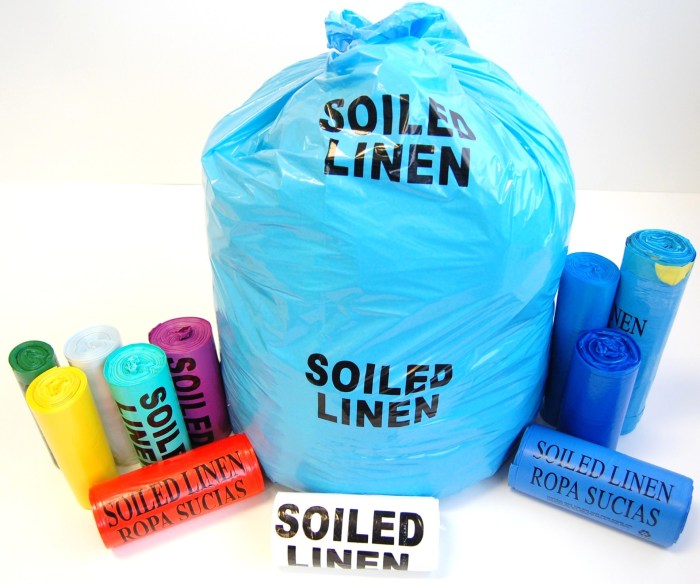
Adhering to regulations and standards is crucial in soiled linen handling to ensure the safety of healthcare workers, patients, and the environment.
Failure to comply can result in serious consequences, including fines, legal liabilities, and reputational damage. Therefore, it’s imperative to understand and meet regulatory requirements.
Relevant Regulations and Standards
- Occupational Safety and Health Administration (OSHA) Bloodborne Pathogens Standard (29 CFR 1910.1030)
- Centers for Disease Control and Prevention (CDC) Guidelines for Environmental Infection Control in Health-Care Facilities
- American National Standards Institute (ANSI)/Association for the Advancement of Medical Instrumentation (AAMI) ST58:2013 Chemical Sterilization and High-Level Disinfection in Health Care Facilities
- The Joint Commission (TJC) Environment of Care Standards
Consequences of Non-Compliance
- Increased risk of infections
- Occupational exposure to bloodborne pathogens
- Environmental contamination
- Fines and penalties
- Reputational damage
Guidance on Meeting Regulatory Requirements, Soiled linen should be bagged
To ensure compliance, healthcare facilities should:
- Develop and implement written policies and procedures for soiled linen handling.
- Train staff on proper handling techniques.
- Provide appropriate personal protective equipment (PPE) for staff.
- Establish a system for the safe disposal of soiled linen.
- Regularly monitor and evaluate compliance with regulations.
Staff Training and Education
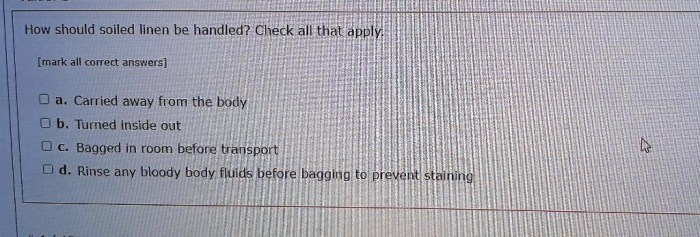
Staff training is crucial in soiled linen handling to ensure the safety and well-being of staff, patients, and visitors. It helps staff understand the risks associated with soiled linen, proper handling procedures, and the importance of compliance.
Effective training programs include hands-on demonstrations, interactive simulations, and regular refresher courses. They should cover topics such as the classification of soiled linen, proper handling techniques, infection control measures, and environmental considerations.
Education
Education plays a vital role in promoting compliance and best practices. It helps staff understand the “why” behind the procedures, fostering a sense of responsibility and ownership. Education programs can include workshops, seminars, and online resources that provide in-depth information on the importance of proper soiled linen handling.
FAQ Overview
What are the types of bags suitable for soiled linen?
Soiled linen bags should be made of leak-proof, moisture-resistant material and have a closure mechanism to prevent spillage.
How often should soiled linen be removed from patient areas?
Soiled linen should be removed from patient areas as frequently as possible, typically every 8-12 hours.
What are the consequences of non-compliance with soiled linen handling regulations?
Non-compliance with soiled linen handling regulations can result in fines, penalties, and damage to the facility’s reputation.
